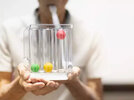We all know that COVID-19 causes infection in the respiratory system, leading to breathlessness and the formation of mucus. In severe infection, it can even cause pneumonia that can damage the lung tissues. This makes it crucial to take the necessary step to strengthen the lungs and clear the air passage when suffering from COVID-19 and post-infection. One of the easiest and surest ways to do it is by performing lung and breathing exercises, which is also known as chest physiotherapy.
Here we will tell you about some easy exercises that you can perform at home while recovering from COVID-19. Remember to take it slow and gradually increase your number of repetitions, else it will leave you breathless.
Here we will tell you about some easy exercises that you can perform at home while recovering from COVID-19. Remember to take it slow and gradually increase your number of repetitions, else it will leave you breathless.











